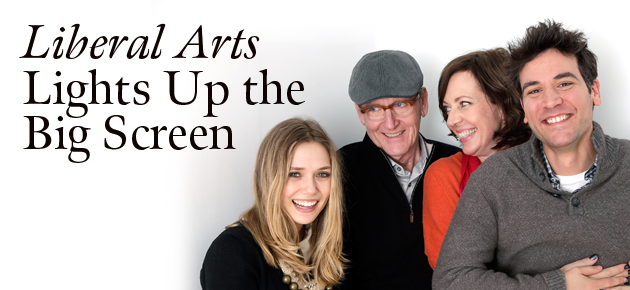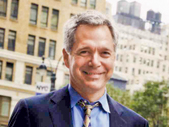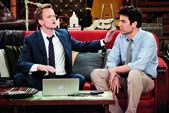Volume 35 Number 1 Fall 2012
In this Issue
Features
- Think Again
- In Land We Trust
- Quiz Kids
- Liberal Arts Lights up the Big Screen
The Editor's Page
- Letters to the Editor
Along Middle Path
- Gambier is Talking About...
- Test your KQ
- Distinguished Decade
- Anatomy of an Athlete
- Restoring Middle Path
- Pass/Fail
- Margin of Error
- Kenyon in Quotes
- The Hot Sheet
Books
- The Sensualist
- Recent Books by Kenyon Authors
Office Hours
- Doing What Comes...Culturally
- Masters of the Art
- Almost to the Lighthouse
Alumni News
- Class Notes
- Mindful Medicine
- Back to Africa
- The Road to Broadway
- Obituaries
- Alumni Digest
The Last Page
- Campaign 2012: A Negative Space Race

Another Kenyon Connection

From the moment the president of IFC Films heard that the new Radnor movie premiering at Sundance was filmed at Kenyon, he could hardly wait to see it. More...
On Location
One of the stars of Liberal Arts is Kenyon itself. More...
The Rise and Rise of Josh Radnor

One of the stars of Liberal Arts is Kenyon itself. More...
Always Impressive
.jpg)
As the aloof, alluring Professor Fairfield, Allison Janney delivers another masterful performance. More...
A gem-like little college way out in Ohio sets the romance in motion.
Jesse is thirty-five, newly single in New York, a book-lover suffering from existential drift, wondering whether there's more to adulthood than the laundromat and an uninspiring job. Out of the blue, he gets a call from a former professor and mentor who is retiring and invites him to the farewell dinner. And so he finds himself, jarringly, intoxicatingly, back at his alma mater, where he begins to fall in love: with the old pleasures of perpetually youthful academia; and, maybe, with Zibby, a pretty sophomore who's just nineteen but sophisticated beyond her years.
Liberal Arts, the new film by writer/director/actor Josh Radnor '96, opens across the country on September 14. And, although the story's Ohio college is never named, this is a Kenyon movie through and through.
It was filmed on campus, during the summer of 2011, with Kenyon students and recent alumni working on the crew. A good many students, faculty, and staff appear as extras. Radnor stars as Jesse, and one of his co-stars is fellow graduate Allison Janney '82.
The campus itself figures as more than a setting; it's a charmed, resplendently green realm that evokes longings for greater meaning in life. Books, classical music, writing, and conversation emerge as motifs—very “Kenyon” themes. The fictional college also happens to have a fabled English department, post-office boxes where everyone picks up mail, an amorphous dating scene, and bleak Februaries. (And a treat: The credits include a cheeky rendition of “I Want a Kenyon Man” by Colla Voce, the Kenyon a cappella group.)
Radnor has been generous about sharing his achievement with the Kenyon family. He came to campus for a screening and discussion on September 2, along with distributor Jonathan Sehring '78 and producer Jesse Hara. Kenyon groups around the country, meanwhile, will enjoy special screenings in September and October.
The Bulletin is pleased to celebrate the opening of Liberal Arts with an array of articles about the film and its creator. Dim the lights, please.
"A World at my Disposal"
Assistant Professor of Film Jonathan Sherman spoke with Josh Radnor about Liberal Arts at Radnor's home in Los Angeles in June. An edited version of the interview is printed here. Video excerpts can be found on Kenyon's Facebook page.
Jonathan Sherman: Everyone at Kenyon is really excited about this film. Tell us how you decided to make a movie at your alma mater.
Josh Radnor: Two years ago, I returned to Kenyon to show my first movie, happythankyoumoreplease. I was thirty-five at the time, talking with all these great students, and I suddenly realized how much older I was than everyone else. Time started to bend in this weird way; it was the first time I had that feeling of, “Oh, Father Time stops for no one.” I said to my producer, Jesse Hara, that I felt so much older, and said, “If I fell in love with a student, that would be really inappropriate.” He said, “That's a great movie.” Then this light bulb went off and I started writing. One thing I realized was I had this whole world at my disposal that I knew incredibly well.
JS: You mean the world of Kenyon?
JR: I just knew the world, knew the professors, and knew the language. Setting a movie at Kenyon allowed me to speak in a heightened, slightly erudite way without seeming pretentious. You're on that hill, you're having conversations with your professors, and students are learning a new way to speak. It was great fun, also, in terms of, you know, thinking about how to use the campus. I love the Richard Linklater films Before Sunrise and Before Sunset, which are kind of a model of a boy and a girl walking around getting to know one another. So there's a section of Liberal Arts that's an homage to that, basically. I composed this sequence where Jesse and Zibby meet in the coffee shop and walk down Middle Path, they go to the Hill Theater, and they go to the chapel. You know, you do that at Kenyon; I always want to do that when I'm back with people. I always want to walk down to the theater; I always pop into the chapel just because it's so beautiful in there.
JS: Did you outline the story, then, almost by way of Kenyon locations?
JR: No, I started writing conversations between this thirty-five-year-old guy and this nineteen-year-old student. I actually found the early doodlings, and maybe a line or two ended up in the movie. It was a way for me to get these two characters talking and kind of alive in my head. I was trying to create a guy in New York where things were going very badly for him. Then he gets a call from his favorite professor at this small liberal arts college, which is unnamed in the movie. Well, the professor is named.
JS: Yes, he's named. But he's based on somebody. Are you allowed to talk about that?
JR: Well, yeah. His name is Peter Hoberg. My father worked at a law firm for over forty years, and for characters I sometimes take the surnames of his partners. John Hoberg was a partner of his; he's actually an extra in the movie. He's a great guy. And Peter Rutkoff [of the American studies faculty] was and remains a dear friend of mine. I wrote the part for Richard Jenkins, who plays Peter.
JS: But how did you get the idea of this inciting incident, of a professor retiring to actually start the movie off?
JR: It just seemed like, how do you get him back to campus? I knew I wanted to show this close student-teacher relationship. One of the things I loved about Kenyon was that kind of rock-star status that some professors get.
JS: And cultivate?
JR: (Laughs) And cultivate. The kind of worship that the students lovingly participate in. I remember how, when a certain professor walks by, there's this hush that comes over certain people. And I wanted to show all that. I mean, that's how Jesse responds to Judith Fairfield, who's played by Allison Janney. He really can't speak around her. He's still so nervous after all those years, because he's just so in awe of her intellect and passion.
JS: Jesse is always burying himself in a book. Why did you come up with that detail for the character?
JR: I always had him carrying a book. A friend read a draft and he said, “Get his head in the book more, so that when Zibby comes, his head comes out of the book.” So I built in this almost obsessive reading . . . . life calls him when he has to deal with something, but then he would go back to the book, go back to the book, and go back to the book. It was kind of a drug for him, this kind of escaping, narcotizing thing.
JS: He's hiding in books?
JR: He's hiding in books, yes, he's disengaging from the world, which I think is the opposite of literature's highest purpose. There's a running thing in the movie about this huge book that this one kid on campus is reading. It's not that hard to decipher, but it's clearly David Foster Wallace's Infinite Jest. Jesse quotes Wallace, who said that the purpose of fiction is to combat loneliness. Jesse says something about the paradox of how spending most of your time with an eleven-hundred-page book tends to put a dent in your social life. How do you divide your time between reading about life and living life? And I think the same thing about writing about life and living life. That's always something I'm wrestling with.
JS: That's interesting in terms of how it connects to the desire to return to a place like Kenyon, where the love of reading is instilled. It's probably one of the few places in the world where it's OK to bury yourself in a book. It's part of a liberal arts education. And yet Jesse is running from the world, too.
JR: He's become someone who is a little inward and a little timid about stepping out into the world in a vital way.
JS: Did you know at Kenyon that you wanted to be an actor?
JR: Yes.
JS: Which professors were supportive and told you that they thought you could do this for a living?
JR: Well, the Drama Department when I was there was Tom Turgeon and Harlene Marley, and Wendy MacLeod was there, and Andrew Reinert. Harlene was my advisor; I was very close with her. She directed me many times. Tom directed me in Romeo and Juliet. I took a semester off and went to the National Theater Institute in Connecticut and did a lot more technical training; it was a beautiful experience. I found nothing but encouragement from Kenyon. There was never anyone who pulled me aside and said, “I don't think this is for you.”
JS: Why make the transition from actor to director? Is it a situation where you wanted more control over your roles? You wanted better roles? Have you always wanted to be a director?
JR: It came about half-accidentally, because I wrote happythankyoumoreplease to give myself a great film role. I wanted to give myself the kind of role that, if I had come across it, I probably wouldn't be getting it. So if I wrote it, I come with the deal. My producer, Jesse, and my agent, Rhonda Price, got very keen on me directing. I think directing is in my DNA. As an actor, I was always a little too worried about things that weren't in my sphere to be worrying about. I would sit in tech rehearsals [in stage productions] and look up, hoping they would fix that light. Is someone going to fix that light? It's not my job, right? I always wanted to pop out into the theater and see the whole thing—how it was going to look and how all the elements were going to come together. I appreciate moments when I'm behind the camera, moments when I'm not feeling self-conscious as an actor . . . . I found there is great joy to thinking big-picture. It's the difference between playing in an orchestra and conducting an orchestra. You get a fuller sound as a conductor than from your own violin, even though you're participating having great joy. I love being in an ensemble. My movies are very much ensemble pieces; everyone gets an aria at the very least.
JS: Do you have movies that you watch every year, or any favorites?
JR: I'm a big fan of Tootsie. I think it's a perfect movie, and one of the rare movies that works even though it had about eight screenwriters. I love Broadcast News, and I'm now crazy about The Apartment. That's a movie I want to study.
JS: I teach a class on Billy Wilder and Preston Sturges at Kenyon, and when we watch The Apartment, people applaud at the end.
JR: It has such a deft touch. You don't even realize that it's dealing with intense, dark themes such as infidelity and suicide. It's all in The Apartment, but for some reason you're just thinking that it was a delightful movie.
JS: There's a lot of classical music in Liberal Arts. Where did that come from?
JR: Classical music to me occupies the same sphere as Wordsworth and Keats. It felt romantic in every sense of the word. . . . I liked playing with the notion of what the music could be doing to Jesse and to his heart. I thought it would be beautiful if Jesse and Zibby were writing letters back and forth about classical music. It also felt old-timey, and I'm very conscious of that in my movies, because I want them to age well. So there are no references to Twitter or Facebook, no texting, and not many cell phones. I want the movies to have a sturdiness to them. . . . I thought that a great thing about Kenyon is that it doesn't change, largely. . . . I love that sturdy dependability.
JS: I was thinking about what makes this movie particularly “Kenyon.” I don't think it would work as well if it were set at a liberal arts college in a city. I wonder if you thought about that when you were writing.
JR: I wanted the juxtaposition of New York and Kenyon. . . . I wanted Kenyon to have that lost-Eden quality—strolling on Middle Path, talking about ideas. You know, you can talk about ideas at Kenyon; people in the world aren't doing much of that. I wanted it to feel different.
JS: It seems to me that when Jesse goes back, he's just as much in love with Kenyon as he is with Zibby. He's romanticizing this past, this Eden.
JR: I think she's conflated with the college, and I think in some ways he can't see straight because he's at a crisis point in his life; he's grasping and trying to rewind. He's trying to turn the clock back, and it doesn't work. Peter says that to him. You cannot go backwards; it's against the laws of nature.
JS: People may recognize, in the Allison Janney character, a certain figure in Kenyon's Drama Department, and I don't know if that was intended.
JR: Harlene Marley, right?
JS: Yes, her mannerisms.
JR: That was Allison, because I did not write that part thinking of Harlene at all. . . . The one thing I was really insistent about with Allison was not to be afraid to go with the language in a grand way, because she [Judith Fairfield, the character] speaks in complete sentences in a very heightened way. I told her to really lean into the diction. Fairfield is a professor who enjoys reading these poems out loud to her class. There's a kind of grandiosity to her, and don't be afraid of it. At one point, on her first day of working, I told Allison how she sounded like Harlene. She went into this Harlene thing. I just think her performance is brilliant. I don't care where she got it, but I didn't base the character on Harlene.
JS: You say that part of the message of your movies is that life is hard and you're going to suffer. But, after both of your movies, people leave the theater very happy.
JR: I call it resolving the chord. . . . It's kind of like the Boy Scout rule—leave it better than you found it. I want to leave my characters better than I initially found them. . . . A great definition of a miracle is a shift in perspective. My movies are about people shifting their perception. The situations don't change that much in my movies; perception changes. That can be an opening to a whole new world for you, if you're able to shift that. I wrote an article when happythankyoumoreplease came out called, “Why I chose happythankyoumoreplease over sadscrewyougetlost.” It was basically a defense of optimism in movies, a defense of something more uplifting and non-cynical.
Gambier, Ohio 43022
(740) 427-5158

 Delicious
Delicious Facebook
Facebook StumbleUpon
StumbleUpon Digg
Digg reddit
reddit